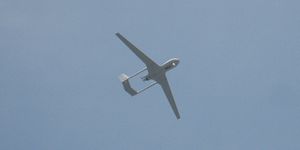Woody Island has been at the center of China’s slow but sure bid to increase its power projection capabilities in the South China Sea. J-11 fighters have been long spotted on the island—the largest in the Paracels. Moreover, early this year, China’s HQ-9 surface-to-air missile systems made an appearance on the island as well (joining advanced anti-ship cruise missiles, among other armaments).
The latest addition to Beijing’s growing repertoire of military technology on Woody Island is the Harbin BZK-005 surveillance drone. New satellite imagery acquired by ImageSat international, taken in early April 2016, shows the drones sitting on China’s Woody Island airstrips for the first time. It’s unclear if China has the requisite logistical support necessary to operate BZK-005 drones on a permanent basis from Woody Island. April’s imagery showed a single drone sitting out in the open on the airstrip; the BZK-005 could have been on Woody Island for a unique patrol.
Previous satellite imagery has shown the BZK-005s, which have primarily been used in the East China Sea to date, at the Daishan Island airfield in Hangzhou Bay. “The Daishan airfield is one of the few dedicated facilities for drone operations known in China,” writes Chris Biggers, a satellite imagery analyst at Bellingcat.
The BZK-005, which has sometimes been described as China’s Global Hawk—referring to the United States’ RQ-4 surveillance drone—does not carry any arms and is intended for high altitude, long-range surveillance missions. The drone features more than 40 hours of endurance, according to specification estimates. It was first unveiled to the public at the Zhuhai International Airshow in 2006.
The addition of surveillance drones to China’s South China Sea arsenal shouldn’t come as a surprise. Everything about Beijing’s actions on Woody Island has suggested an expanded focus on enabling power projection. Though China has yet to move fighters or drones to its newly built artificial islands in the Spratly Islands, it is conceivable that Chinese BZK-005s could operate off the newly constructed airstrips at Subi and Fiery Cross Reefs in the Spratly Islands.
China has shown interest in expanding its intelligence, surveillance, and reconnaissance capabilities in the South China Sea. Satellite imagery first released by The Diplomat late last year showed a possible over-the-horizon radar receiver station under construction at Cuarteron Reef in the Spratlys last year. China could look to augment its reef-based radar facilities with aerial surveillance for superior domain awareness in the South China Sea, far outdoing the capabilities of any other regional claimant states.
To date, the BZK-005 has been a mainstay of the People Liberation Army’s activities over the East China Sea, where China has a separate ongoing dispute with Japan over the sovereignty of the Senkaku/Diaoyu Islands. In late 2013, Japanese authorities had scrambled jets to monitor and track what they described as a “drone of unidentified nationality.” Imagery released by the Japanese government later all but confirmed that the drone in question was a Chinese BZK-005.

































